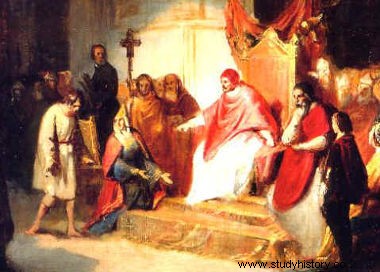
By Me. Cláudio Fernandes
One of the most important points to understand the relationship between ecclesiastical power and imperial power in the Middle Ages is the question of investitures. The investment it was the action of appointing clerics to important positions, such as bishops and abbots. In the period of the High Middle Ages, at the time of the Kingdoms Franc , it was common for the king to found monasteries and abbeys and to invest clerics in positions of great importance, both for the Church and for the kingdom. However, from the 10th century onwards, reform movements began within the ecclesiastical sphere. The monks of Cluny Abbey , in France, stood out in this process for demanding more political autonomy from the Church. These demands clashed with the interests of the Holy Roman Empire, causing the so-called Investiture Quarrel .
The central problem of the quarrel, or dispute, of the investitures was the fact that the highest ecclesiastical authority, the Pope, was weakened before the power of the emperors over the Church. In the 11th and 12th centuries, the contention between Emperors and Popes became very wide. One of the highlights came when Pope Gregory VII promoted his wave of reforms, which included procedures such as the reaffirmation of celibacy clerical and the ban on emperors appointing (or investing) clerics in Church positions – that role would be up to the Pope alone.
Gregory VII was deeply guided by the positions of the College of Cardinals , created by Pope Nicholas II , and for the reforming ideas of the Abbey of Cluny, from which he came. Pope Gregory's reforms put in check the power of the Holy Emperor Henry IV , who, in response, wanted to take papal authority away from Gregory VII and transfer it to Clement III . Faced with this affront, Gregory VII excommunicated Henry IV in 1076.
Many German principalities linked to the Holy Empire took advantage of this episode to declare themselves independent, considering Henry IV deposed as Holy Emperor. Faced with this pressure, Henry IV traveled to the city of Canossa, in Italy, where the Pope was, to redeem himself for his actions and ask for forgiveness, in the episode known as Canossa's Penance (see image at top). Gregory VII withdrew the excommunication of Henry IV, but the problem had already taken on greater proportions, given that the German aristocracy had elected a new Holy Emperor to face Henry IV, his name was Rodolph of Swabia.
The problems related to the power to invest clerics by the “spear” (Emperor) or the “staff” (Pope) continued for decades. The most reasonable solution to the dispute was found in the so-called Worms Concordat , in 1122, also known as Pactum Calixtinum , signed byPope Callisto II and by the Holy EmperorHenry V , who divided the investiture between that made by the king (who gave secular authority) and that made by the Pope, who gave spiritual authority.
